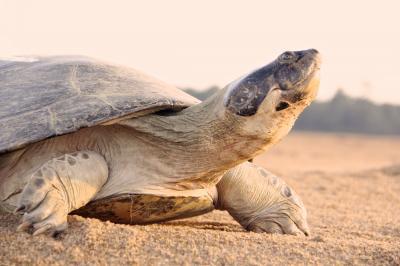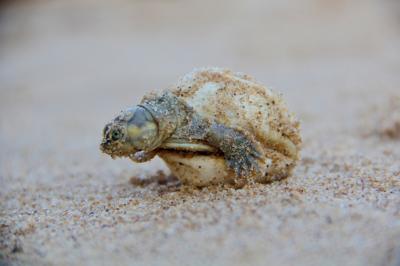Sounds made by the turtles while migrating through the river or basking tended to be low frequency sounds, possibly to facilitate contact between turtles over longer distances. Vocalizations made during nesting tended to be higher frequency sounds, possibly because higher frequency sounds travel better in shallow water and in the air.
The highest diversity of sounds are used by females about to nest; the researchers theorize that the animals use these sounds to decide on a specific nesting site and to synchronize their movements (the turtles leave the water in a single-file procession).
The hatchling turtles themselves make sounds before they hatch and continue to do so as they clamber out of the nest chamber on the river beach. The sounds, the authors speculate, may stimulate group hatching. The females, in turn, vocalize in response to the nestling calls, perhaps guiding the nestlings into the water. These interactions—the first recorded instance of parental care in turtles—were featured in a 2012 study appearing in the Journal of Comparative Psychology.
Using sonic transmitters, the team also discovered that the hatchlings remain together and migrate with adult females for more than two months.
The Giant South American river turtle is the largest of the side-necked turtle family and grows up to 80 centimeters (nearly three feet) in length. The species is only found in the Amazon River basin and is now threatened by unregulated consumption of the turtles' meat and eggs.
"Groundbreaking studies such as this one can help us better understand the complex relationships between both individual animals and their environment," said Dr. Julie Kunen, Executive Director of WCS's Latin America and the Caribbean Program. "Protecting the still sizable populations of Giant South American river turtles will also enable us to conserve the behavioral richness of these reptiles for future study."
Research on the Giant South American river turtles is part of a new long-term WCS conservation program called Amazon Waters, an initiative focusing on the conservation of aquatic ecosystems and species.

This is an adult Giant South American river turtle. The turtle is the largest member of the side-necked turtle family and grows up to nearly three feet in length.
(Photo Credit: Photo : C. Ferrara/Wildlife Conservation Society)
The Wildlife Conservation Society works to save turtles and tortoises around the world. In 2012, WCS launched an organization-wide program to revive some of the most endangered turtle and tortoise species. Efforts include breeding programs at WCS's zoos in New York, head start programs abroad, and working with governments and communities to save species on the brink of extinction.

A Giant South American river turtle hatchling emerges from its shell.
(Photo Credit: Photo : C. Ferrara/Wildlife Conservation Society)
Source: Wildlife Conservation Society